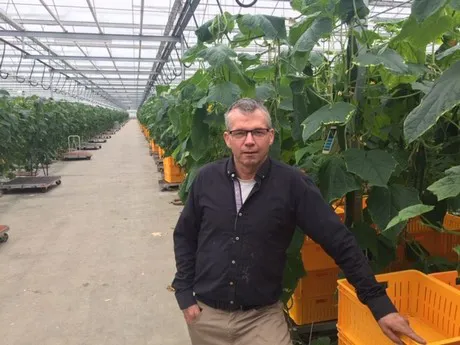The greenhouse horticultural company Polman, located in the Dutch town of Erica, grows cucumbers year-round in rockwool. In one garden, with a surface area of 5.6 hectares, they grow three traditional high wire crops, and in another garden, 4.0 hectares, they have four crops with interplanting in the middle of April and June. “The water we use for the cultivation needs to be completely disinfected since the risk of infection with viruses like the mosaic virus is high,” Hans Polman says. He is a member of the national commission Cucumber and is a board member of the crop cooperation Cucumber.

Mixing in tap water on time
The cucumber company has over 30,000 cubic meters worth of rainwater basins. During times of drought, they will be filled with tap water. “The tap water contains a few millimoles of sodium. If we were to switch to using tap water only, we wouldn’t be able to keep on recirculating the water, which is something we need to try and prevent”, Polman says.
“We can mix up to 25 percent tap water in with the rainwater and still keep on recirculating the water. During a very dry summer we therefore need to start mixing in the tap water early on, in the middle of July. We rather mix it in too soon than too late. Around the middle of August, we can usually tell if it is still needed to mix in tap water.”
Disinfecting drain water
The cucumber company uses both hanging gutters and PVC-gutters in the ground to drain the water. Both locations (4.0 hectares and 5.6 hectares) keep their drain water separated. The drain water goes to wastewater silos before getting disinfected, after which it ends up in clean water silos for storage. Then it can be mixed in the blending bowl of the unit.
There is another wastewater silo outside for the storage of water they do not want to reuse, for example, the last water used for cultivation and the water used for cleaning after a crop rotation. After purification with ozone, this water can be discharged into the surface water.
A large ozone installation
Last year, Polman purchased an ozone-installation with a capacity of 24 m3 per hour to disinfect and purify the water. The ozone equipment has three pipes that connect to the two gardens and the wastewater silo. “We have heaters, that are about twenty years old and should be replaced, in each garden. The reason we chose to use ozone is because the heaters can’t be used to purify the water, the drain water remains cold after sanitation, and we have the knowledge and experience of the supplier close at hand.”
Ozone and heating
“Last year, because of the extraordinary summer, the industry faced more problems with Pythium than in previous years,” says the cucumber grower. “After all, it was an extremely warm summer with temperatures reaching 38 degrees Celsius. In times like that, it's essential to have a functioning disinfectant. The water samples that were taken from the heaters and the ozone installation both showed positive results, so we can remain using both techniques if need be. Also, Agrozone has conducted a water scan for the entire company, providing us with great insights.”
Foaming difficult to decontaminate
Not only the last water used for cultivation but also the first drain water, which comes from the rockwool mats after they are filled, is being deposited in the wastewater silo and will not be reused. The percentage of water that is being reused is more than 90 percent each year. Polman: “Due to foaming, the ozone has trouble disinfecting the first drain water. The same goes for the water used during the crop rotation, because of the high amount of remaining roots and organic material, foaming occurs for a few days. Agrozone is currently developing a spray cone to counter the accumulating foam.
The fabric filters the water from the greenhouse before ending up in the dirty drain water silos also face problems due to the organic matter. The dirty water is difficult to filter because slime clogs up the fabric filter. It's easier, and faster, to change the fabric filter for a clean one, but there comes a time this won’t work anymore, and the fabric filter will malfunction as a result of the high water levels.”
Source: Glastuinbouw Waterproof
